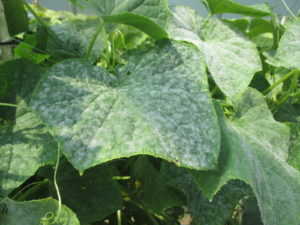Powdery mildew is particularly severe in high tunnel and greenhouse growing conditions (Figure 1). It affects a wide range of crops including tomatoes and cucumbers. In addition to using synthetic fungicides to control this disease in high tunnels, we found powdery mildew on cucumbers can also be effectively controlled through variety selection and intensive plant pruning.
Cucumber cultivars grown in high tunnels are parthenocarpic. Most of these cultivars are marketed as powdery mildew resistance. However, there are actually a wide range of different levels of resistance existed among parthenocarpic cultivars. In our trials, we found Japanese type cucumbers, especially cultivar Tasty Jade, was very susceptible to powdery mildew; Taurus was less susceptible than Tasty Jade, but much more susceptible compared to most Beit alpha (or mini) type, long English (or Dutch greenhouse) type and American slicer cucumbers. Comparing three long English cultivars in our evaluation, Kalunga was more susceptible compared to Camaro and Tyria. Among six Beit alpha cultivars, Jawell was more susceptible than Katrina, Socrates, Manny, Manar and Picolino. The four American slicer type cultivars Corinto, Lisboa, Alcazar and Sweet Success were relatively more resistant to this disease.
As a rule of thumb, powdery mildew shows up on the older leaves first. These leaves often no longer have significant contributions to plant growth and fruit production. If old leaves can be removed in a timely manner, the spread of this disease can be greatly delayed, especially on varieties that are less susceptible to powdery mildew. With an intensive pruning system (plants were trellised in a one leader system, older leaves were pruned weekly, leaving about 15 of the youngest leaves for fruit production), powdery mildew can be effectively controlled on most cucumber cultivars.
Although a variety may be listed as resistant, it is important to understand that cucumber resistance to powdery mildew is controlled by multiple genes, and is environmentally dependent. It was known that for some cultivars that show resistance to powdery mildew under high-temperature conditions, may loss resistance when grown in greenhouses from winter to spring. In those cases, controlling this disease with fungicide spray may be more effective.
This project is supported by NC-SARE under project number LNC17-390 ‘Improving Seedless Cucumber Production to Diversity High Tunnel Crops in the North Central Region‘.
